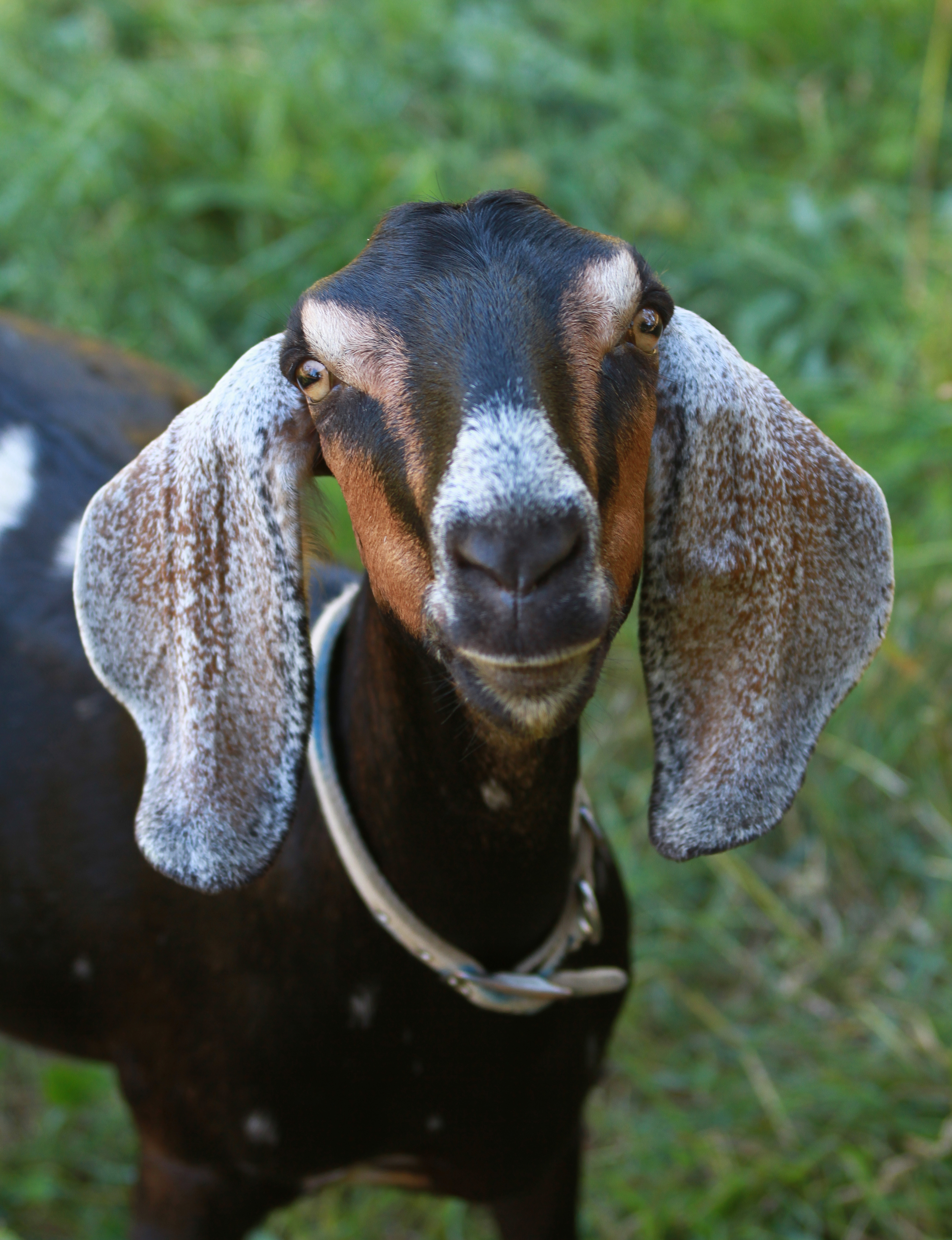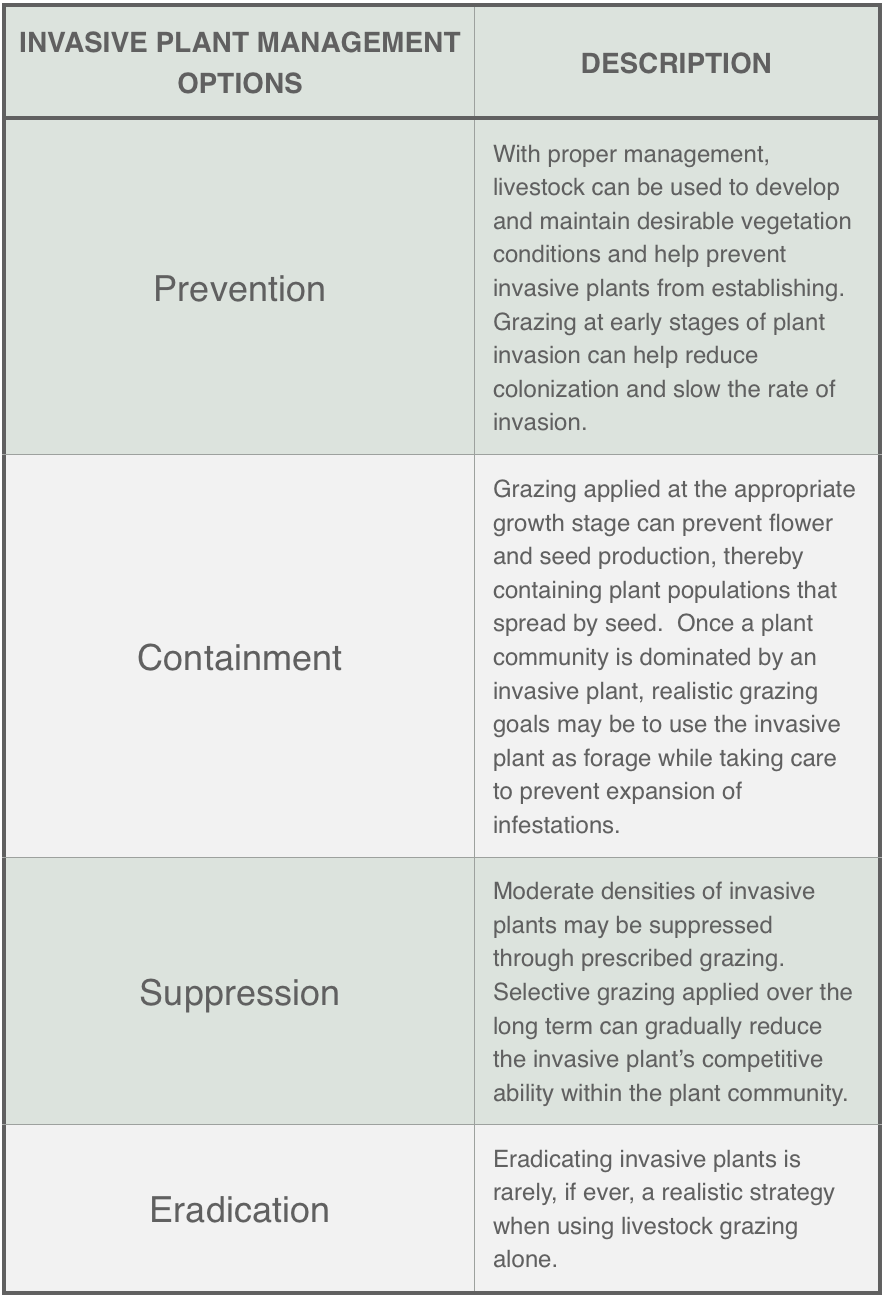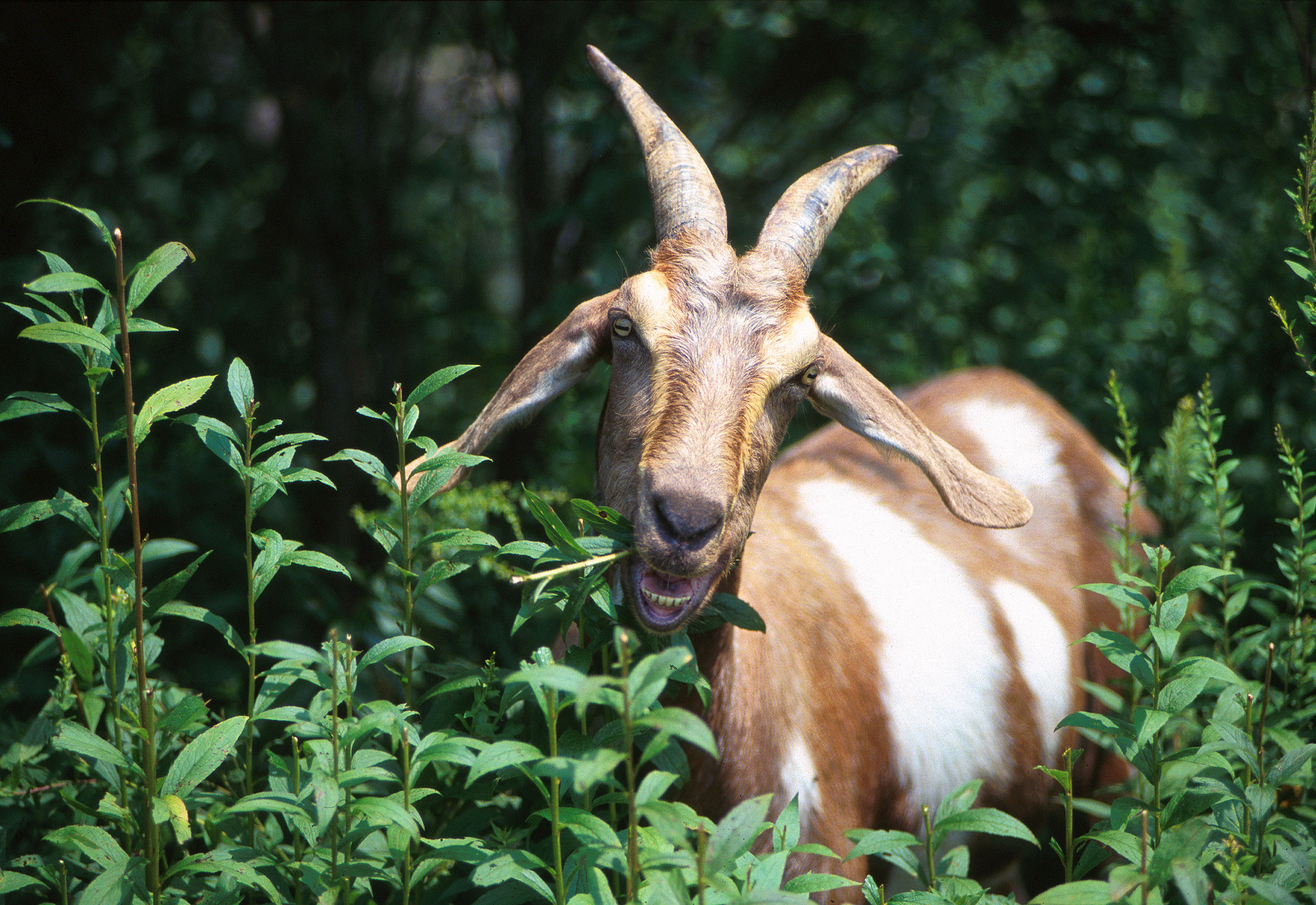Invasive Species
Claire M. Beck
Invasive species are taking over natural landscapes. While chemical control methods have been used in the past, biological controls, such as the use of goats to manage invasive species, are gaining public interest. Are goats the best answer to the growing problem of invasive plants?
The proliferation of non-native, invasive plant species throughout the United States poses both ecological and economic threats.1,2,8 Non-native invasive plants are plant species that were introduced, intentionally or unintentionally, to a natural landscape and displace native plant species, alter wildlife habitat, and negatively impact cultivated species important to the economy. These plants out-compete native plant species for space and resources.8 A recent economic impact assessment estimated that the environmental damage caused by non-native invasive species (including plants, animals, and microbes) in the United States is approximately $120 billion per year.8 At least $35 billion of this estimate can be directly attributed to invasive plants.8 In addition to the economic impacts of invasive plant species, the ecological impacts can be devastating for native wildlife species that depend on native plants for food, shelter, or breeding. Furthermore, climate change is likely to impact the spread of invasive species and viability of native species in a way that will make control methods more difficult and expensive.2

While much research has been devoted to documenting invasive species and experimental methods of control, much less research has focused on effective control methods that can be applied by landscape and natural resource managers on a large scale. Control methods for invasive plant species are a huge contributor to the overall cost of the invasive species problem and can include: chemical by use of herbicides, mechanical through mowing or burning, or biological by introduction of a species that preys upon the invasive species in some way.7 One method of biological control that has received increasing public interest is the use of targeted goat grazing.
Recent research on the effectiveness of goat grazing for controlling invasive phragmites in U.S. wetlands has reignited discussion of goat (or other herbivore) grazing as a safe, cost-effective method of controlling invasive plant species.6 Prescribed goat grazing of non-native invasive plant species is particularly attractive to the public due to its relative safety (as opposed to herbicides) and possible reciprocal benefits of providing income for farmers and free fodder for goats.9 Using goats to control invasive plant species is also preferable to other biological control methods, such as insect releases, since the movement and spread of captive livestock can be more easily controlled and does not pose a threat of an unintended secondary invasion. Goat grazing to control weeds gained mainstream attention in 2013 when goats were used to clear honeysuckle, ivy, and poison ivy from the congressional cemetery in Washington, D.C.6
The use of goats to control invasive plants may be a win-win situation, whereby society gets the benefit of reduced damage from invasive plant species, and farmers profit from a plentiful and free source of food for livestock. However, there are still many questions regarding when and where goats are an effective control method, and if providing goat grazing services is a viable business model for farmers.

Research on prescribed goat grazing reveals that this method’s effectiveness is highly context dependent and varies greatly by geographic area, species of interest, and application of long-term management schemes. Studies show goat grazing to be effective at reducing cover of English Ivy (Hedera spp., Araliaca),4 Himalaya Blackberry (Rubus armeniacus),3 Yellow Starthistle (Centaurea solstitialis),1 Spotted Knapweed (Centaurea biebersteinii),11 and the wetland plant Phragmites australis (common reed).8 The exact prescription for success in each of these studies is different. For example, English Ivy (Hedera spp., Araliaca) was successfully controlled in a park setting in Oregon when the area of interest was intensively grazed by goats for one day in late summer two years in a row.4 Another study conducted in Oregon found that goat grazing was an effective method for reducing cover of the invasive Himalaya Blackberry (Rubus armeniacus) while simultaneously increasing cover of desirable perennial grasses and forbs.3 This study compared the efficacy of goats alone, mowing alone, or goat and mowing treatment together for stimulating growth of desirable plant species.3 Goats have also been effective at controlling Yellow Starthistle (Centaurea solstitialis), especially where this plant has invaded canyon rangelands, which are inaccessible for mowing or application of herbicides.1 Researchers allowed goats to graze a canyon for two months in late summer, and this treatment was repeated for three years.1 The Starthistle percent cover in the area decreased for each consecutive year the treatment was applied.1 When used to control Spotted Knapweed (Centaurea biebersteinii), goats were most effective when the grazing occurred during the “bud to bloom” stage of the plant growth.11 Researchers noted that when this methodology was applied to a city-owned field in Salmon City, Iowa, the number of goats required to clear the land was reduced each year of implementation due to the cumulative effects of knapweed biomass reduction from the prior year’s treatment.11 Another recent study found that goat grazing can be successful at reducing the density of the invasive wetland species Phragmites australis (common reed).9 This study was specifically designed to determine if livestock grazing could control invasive wetland plants in North America, since similar practices have been used in Europe for centuries.9 The researchers discovered that goat grazing was an efficient, effective means of controlling Phragmites australis in areas where the density of Phragmites is high and the goats have limited or no other grazing choices.9 The researchers suggest that timing of the grazing treatment is an important factor that needs more systematic research.9
Figure 3. Invasive Species: English Ivy (Hedra spp., Araliaca), Himalayan Blackberry (Rubus armeniacus), Spotted Knapweed (Centaurea biebersteinii), Common Reed (Phragmites australis), Yellow Starthistle (Centaurea solstitoalis). (References below)
Several private companies exist in the United States that offer goat grazing services to control a variety of undesirable plant species. In addition to the previously mentioned invasive species, private companies advertise goat grazing to control Kudzu (Pueraria lobata), Oriental Bittersweet (Celastrus orbiculatus), Multiflora Rose (Rosa multiflora), Japanese Honeysuckle (Lonicera japonica), and Mile-A-Minute Weed (Persicaria perfoliata).10 Is this method of control financially viable at a large scale? According to Andrew Jenner at Modern Farmer Media, goat grazing as a control method for invasive (or other unwanted) plant species is only economically feasible at small scales and for landowners who do not need to turn a per-acre profit.5 In other words, “rental goats” are affordable for municipalities or civic groups who want to clear out an overgrown roadside or future garden space, but this option is not affordable for ranchers and farmers who need to make a profit off of their land. One solution, according to Jenner, is for rental goat farmers to set up a barter system with other farmers and ranchers.5 In this system, the fee for rental goats is reduced in exchange for the free fodder provided by the other farmer’s undesirable plants.5 This business model has not been extensively tested, and may only be successful for rental goat companies that are simultaneously raising those goats for meat production.5

Academic research on goat grazing to control non-native invasive plant species has focused mostly on the response of individual plant species to goat grazing treatments and the grazing tendencies of the goats. While this information is useful to the study of invasive species control, there has been little attention paid to the economic and managerial feasibility of these specific goat grazing methods. Silliman et al. (2014) propose goat grazing as a management tool with possible economic benefits for farmers and land managers, but this remains unproven in the United States.9 In some European countries, government payments to farmers for the services of invasive species control has created a sustainable model that benefits landowners, resource managers, the general public, and the environment.9 Such a system for invasive species control through livestock grazing has yet to materialize in the United States. Future research into grazing-based solutions to the invasive species problem should address the scientific, social, and economic factors that contribute to management plans so that long-term sustainable and scalable solutions can be developed.
References:
- Goehring et al. (2010). Late-Season Targeted Grazing of Yellow Starthistle (Centaurea solstitialis) with Goats in Idaho. Invasive Plant Science and Management, 3(2):148-154.
- Hellman et al. (2008). Five potential consequences of climate change for invasive species. Conservation Biology, 22(3):534-543.
- Ingham, C.S. (2014). Himalaya Blackberry (Rubus armeniacus) Response to Goat Browsing and Mowing. Invasive Plant Science and Management, 7(3):532-539.
- Ingham C.S. & Borman M.M. (2010). English Ivy (Hedera spp., Araliaceae) Response to Goat Browsing. Invasive Plant Science and Management. 3(2):178-181.
- Jenner, A. (2013, September 18). Goats as invasive species control. Modern Farmer. Retrieved from https://modernfarmer.com/2013/09/goats-invasive-species-control/
- Jolly, J. (2015, January 13). The goats fighting America’s plant invasion. BBC News. Retrieved from http://www.bbc.com/news/magazine-30583512
- Kettenring, K.M. & Adams C.R. (2011). Lessons learned from invasive plant control experiments: a systematic review and meta-analysis. Journal of Applied Ecology. 48(4):970-979.
- Pimentel et al. (2005). Update on the environmental and economic costs associated with alien-invasive species in the United States. Ecological Economics. 52(3):273-288.
- Silliman et al. (2014). Livestock as a potential biological control agent for an invasive wetland plant. Peer J. 2:e567. https://doi.org/10.7717/peerj.567
- Why goats? (2009). Eco-Goats.
- Williams, S. & Prather, T. (2006). Goats: A tool for controlling spotted knapweed. Journal of Extension. 44(5):5RIB6.
Figures:
- Davison, Karl. (2017). [Photograph of English Ivy]. Retrieved from FlickrCommons. CC BY-NC-SA 2.0.
- Endico, Dawn. (2005). [Photograph of Himalayan Blackberry]. Retrieved from FlickrCommons. CC BY-SA 2.0.
- Lavin, Matt. (2015). [Photograph of Yellow Starthistle]. Retrieved from FlickrCommons. CC BY-SA 2.0.
- Lisafern. (2010). [Photograph of female goat on a farm]. Retrieved from Wikimedia Commons. Public Domain.
- Managing Invasive Plants. [Data from chart]. (2009). U.S. Fish and Wildlife Service.
- NY State IPM Program at Cornell University. [Photograph of Spotted Knapweed]. Retrieved from FlickrCommons. CC BY 2.0.
- stux. (2013). [Photograph of Phragmites]. Retrieved from Pixabay. Public Domain.
- U.S. Department of Agriculture. (2013). [Photograph of grazing goat]. Retrieved from FlickrCommons. CC BY 2.0.
